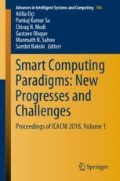Abstract
Speech sounds are classified into 5 classes, grouped based on place and manner of articulation: velar, palatal, retroflex, dental and labial. In this paper, an attempt has been made to explore the role of place of articulation and vocal tract length in characterizing the different class of speech sounds. Formants and vocal tract length available for the production of each class of sound are extracted from the region of transition from consonant burst to the rising profile of the immediate following vowel. These features along with their statistical variations are considered for the analysis. Based on the non-linear nature of the features Random Forest (RF) is used for the classification. From the results, it is observed that the proposed features are efficient in discriminating the class of consonants: velar and palatal, palatal and retroflex and palatal and labial sounds with an accuracy of 92.9%, 93.83 and 94.07 respectively.
Access this chapter
Tax calculation will be finalised at checkout
Purchases are for personal use only
References
Jones, D.: The phoneme: its nature and Use. Cambridge, England, Heffer (1950)
Denes, P.B.: On the statistics of spoken English. J. Acoust. Soc. Am. 35(6), 892–904 (1963)
Clements, G.N.: Place of articulation in consonants and vowels: a unified theory. Work. Pap. Cornell Phon. Lab. 5, 77–123 (1991)
Rabiner, L. R., Juang, B. H.: Fundamentals of speech recognition. Tsinghua University Press (1999)
Hogg, R.M.: Phonology and morphology. Camb. Hist. Engl. Lang. 1, 67–167 (1992)
Grunwell, P.: Phonological Assessment of Child Speech (PACS). College Hill Press (1985)
Shriberg, L.D., Kwiatkowski, J.: Phonological disorders I: A diagnostic classification system. J. Speech Hear. Disord. 47(3), 226–241 (1982)
Eskenazi, M.: Using automatic speech processing for foreign language pronunciation tutoring: Some issues and a prototype. Lang. Learn. Tech. 2(2), 62–76 (1999)
Fukada, T., Tokuda, K., Kobayashi, T., Imai, S.: An adaptive algorithm for mel-cepstral analysis of speech. In: 1992 IEEE International Conference on Acoustics, Speech, and Signal Processing, 1992. ICASSP-92, vol. 1, pp. 137–140. IEEE (1992)
Shrawankar, U., Thakare, V.M.: Techniques for feature extraction in speech recognition system: A comparative study arXiv:1305.1145 (2013)
Zue, V.W.: The use of speech knowledge in automatic speech recognition. Proc. IEEE 73(11), 1602–1615 (1985)
Milone, D.H., Rubio, A.J.: Prosodic and accentual information for automatic speech recognition. IEEE Trans. Speech Audio Process. 11(4), 321–333 (2003)
Manjunath, K.E., Sreenivasa Rao, K.: Articulatory and excitation source features for speech recognition in read, extempore and conversation modes. Int. J. Speech Technol. 19(1), 121–134 (2016)
Garofolo, J.S., Lamel, L.F., Fisher, W.M., Fiscus, J.G., Pallett, D.S.: Darpa timit acoustic-phonetic continous speech corpus. NASA STI/Recon technical report n 93, (1993)
McCandless, S.: An algorithm for automatic formant extraction using linear prediction spectra. IEEE Trans. Acoust., Speech, Signal Process. 22(2), 135–141 (1974)
Stevens, K.N.: Acoustic Phonetics, vol. 30. MIT Press, Cambridge (2000)
Paige, A., Zue, V.: Calculation of vocal tract length. IEEE Trans. Audio Electroacoust. 18(3), 268–270 (1970)
Breiman, L.: Random forests. Mach. Learn. 45(1), 5–32 (2001)
Author information
Authors and Affiliations
Corresponding authors
Editor information
Editors and Affiliations
Rights and permissions
Copyright information
© 2020 Springer Nature Singapore Pte Ltd.
About this paper
Cite this paper
Ramteke, P.B., Hegde, S., Koolagudi, S.G. (2020). Characterization of Consonant Sounds Using Features Related to Place of Articulation. In: Elçi, A., Sa, P., Modi, C., Olague, G., Sahoo, M., Bakshi, S. (eds) Smart Computing Paradigms: New Progresses and Challenges. Advances in Intelligent Systems and Computing, vol 766. Springer, Singapore. https://doi.org/10.1007/978-981-13-9683-0_15
Download citation
DOI: https://doi.org/10.1007/978-981-13-9683-0_15
Published:
Publisher Name: Springer, Singapore
Print ISBN: 978-981-13-9682-3
Online ISBN: 978-981-13-9683-0
eBook Packages: Intelligent Technologies and RoboticsIntelligent Technologies and Robotics (R0)

